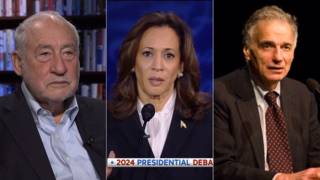
As the Federal Reserve signals it will raise interest rates in March, we talk to Christopher Leonard, author of the new book “The Lords of Easy Money,” about how the Federal Reserve broke the American economy. He details the issues with quantitative easing, a radical intervention instituted by the federal government in 2010 to encourage banks and investors to lend more risky debt to combat the recession. “The Fed’s policies over the last decades have stoked the world of Wall Street,” says Leonard. “It has pumped trillions of dollars into the banking system and thereby inflated these markets for stocks, for bonds. And that drives income inequality.”
Transcript
AMY GOODMAN: This is Democracy Now! I’m Amy Goodman, with Nermeen Shaikh.
Amidst growing concerns about inflation in the U.S., the Federal Reserve announced Tuesday it will start hiking interest rates in March. To look at what this will mean for working people and everyone beyond the 1%, we’re joined by Christopher Leonard, longtime business reporter. His new book is out this week, The Lords of Easy Money: How the Federal Reserve Broke the American Economy.
Welcome to Democracy Now! It’s great to have you with us, Christopher. If you can start off with a Federal Reserve 101: What does it mean to lift interest rates? And why do you say it’s broken, the American economy?
CHRISTOPHER LEONARD: Yes. Thank you. Great question. And, you know, the Federal Reserve can seem like this very kind of obscure and highly technical institution that only matters to Wall Street, but I really think that’s not the case. It is critical to understand what this central bank does and how it has affected our economy. You know, one of my central preoccupations as a business reporter is trying to understand growing income inequality in the United States and why we live in this sort of funhouse-type economy where we can see stock markets breaking records, corporate debt markets breaking records, while the middle class is really treading water with stagnant wages and falling further behind. What the Federal Reserve has done over the last decade helps explain why this is happening.
So, you know, at the root level, we created the Federal Reserve as the central bank to do one key thing: It creates our currency. The Federal Reserve literally creates and manages our currency. That thing we call a U.S. dollar is in reality a Federal Reserve note. So, the central bank’s job is to make sure that the dollar retains its value. So that’s why you always hear this talk about, you know, the Federal Reserve hiked interest rates today, or it cut interest rates today. What they’re doing is expanding or contracting the supply of money.
So, why does that matter? Well, here’s why. Over the last decade, the Fed has really moved itself to the center of American economic life. The Fed has engaged in an unprecedented series of experiments in printing new money. Let me put it this way: In the first century of its existence, the Fed expanded the pool of base money — you know, what the economists called the monetary base. The Fed expanded that pool of money to about $900 billion. So, that’s a trillion dollars in printing money over a century. But then, after the crash of '08, between 2008, 2014, the Fed prints $3.5 trillion. So that's three-and-a-half centuries’ worth of money printing in a few short years.
Now, that money is not a neutral force. When the Fed creates new dollars, it doesn’t create them in the checking account of normal people, right? It creates new dollars — specifically and by design, it creates new dollars on Wall Street in the bank accounts of 24 select institutions. And they’re the folks you’d suspect: you know, JPMorgan, Goldman Sachs, Wells Fargo. That’s where the Fed is creating these new dollars. So the Fed’s policies over the last decades have stoked the world of Wall Street. It has pumped trillions of dollars into the banking system, and thereby it’s inflated these markets for stocks, for bonds. And that drives income inequality, because, you know, just the tiny 1% at the top of our wealth ladder controls 40% of all the assets, whereas the bottom half of Americans, you know, those of us who earn a living by getting a paycheck rather than by owning assets — the bottom half of Americans only own about 5% of all the assets. So the Fed’s policies have enriched the very rich, the biggest of the big banks, while leaving the middle class behind.
And now we find ourself in this position, that’s really actually quite a dangerous moment, in 2022, where we’re seeing price inflation start to increase dramatically. So, the Fed is being forced to tighten the money supply and to try to back off these stimulus programs it’s created. The real risk here, I think, for everybody in America is that as the Fed does this, as it hikes rates and pulls back on the stimulus, it’s going to cause those asset markets to fall. And, you know, to put that in common parlance, it’s risking creating a financial market crash as the Fed is forced to hike interest rates. And again, to me, one of the key problems with this is that over the decade of these easy money policies, the middle class has really been left out. And once again, it will be the middle class that’s going to have to pay the bill if we see another financial market crash.
NERMEEN SHAIKH: Well, Chris, could you respond to what we see everywhere in the media, namely that inflation rates now are almost at 7%, higher than they’ve been since the 1980s? I mean, that level of inflation also impacts the vast majority of Americans adversely. What other steps could be taken to reduce inflation?
CHRISTOPHER LEONARD: So, it’s just fascinating. And one key thing I would really like to point out, that I learned while reporting this book, is that we should, I think, think about two kinds of inflation. There’s inflation of prices, which is what we’re talking about right now, that really sharp increase in the price of food, fuel, television sets, cars. That’s price inflation. But then you’ve got inflation of assets, which is what the Fed has been pushing so hard for decades. So, that’s a rise in the value of homes and stocks and corporate bonds. So we’ve actually had runaway asset inflation for a decade, but we haven’t seen price inflation. And we’re starting to see it now.
And as you point out, price inflation can just, frankly, be devastating for the middle class, if wages don’t keep up with the increase in prices — which, unfortunately, is exactly what we’re seeing now. So, wages are kind of creeping up a little bit, but we’re seeing this runaway increase in prices, which presents us with a terrible dilemma. And to be blunt, the Federal Reserve is responsible for the price inflation, at least to a certain degree, by pumping all of this money into the economy.
So, you know, your question is: How can you fight it, and what can you do?
AMY GOODMAN: We have 30 seconds.
CHRISTOPHER LEONARD: Quite unfortunately, one of the few ways to do this is to hike interest rates, which is going to create damage to our economy. Many other important measures will take a lot of time, such as improving the supply chain or cracking down on monopolies. So, we’re going to see interest rates hiked, and it’s going to be a bumpy ride.
AMY GOODMAN: Well, we clearly have to come back to this conversation, Christopher Leonard, business reporter and author. New book out this week, it’s called The Lords of Easy Money: How the Federal Reserve Broke the American Economy.
And that does it for our show. I’m Amy Goodman, with Nermeen Shaikh. Remember, wearing a mask is an act of love.













Media Options